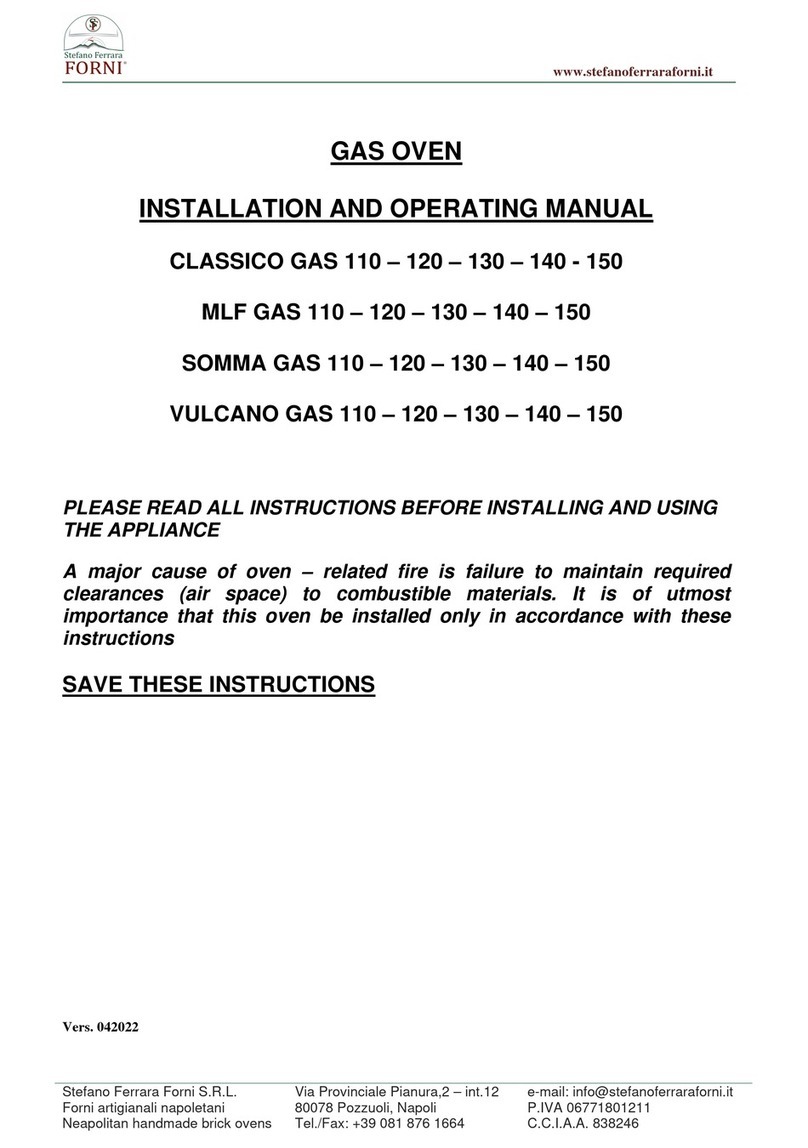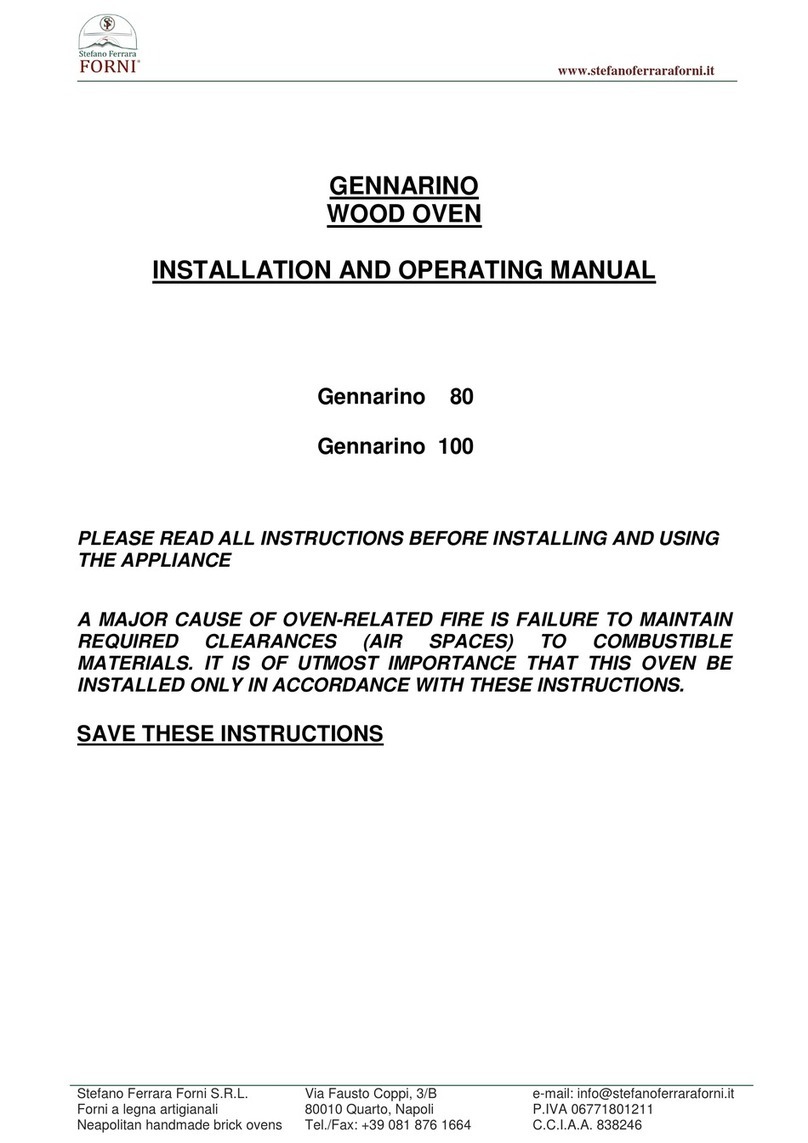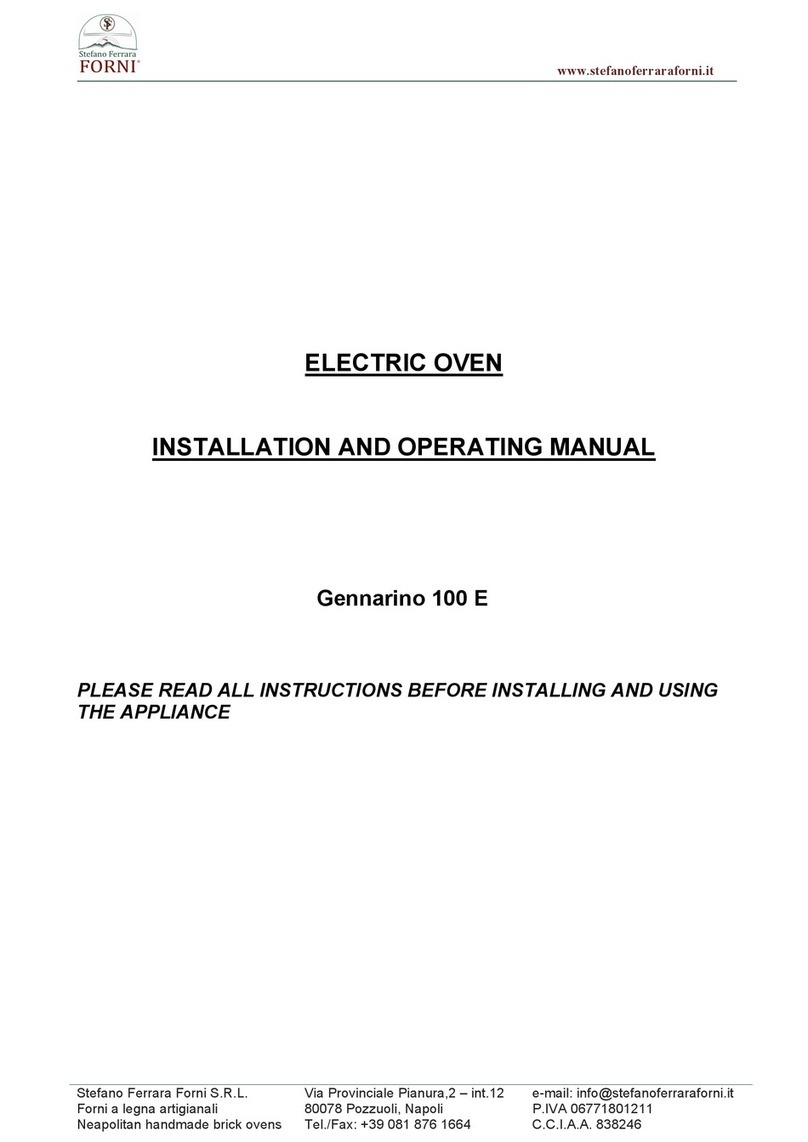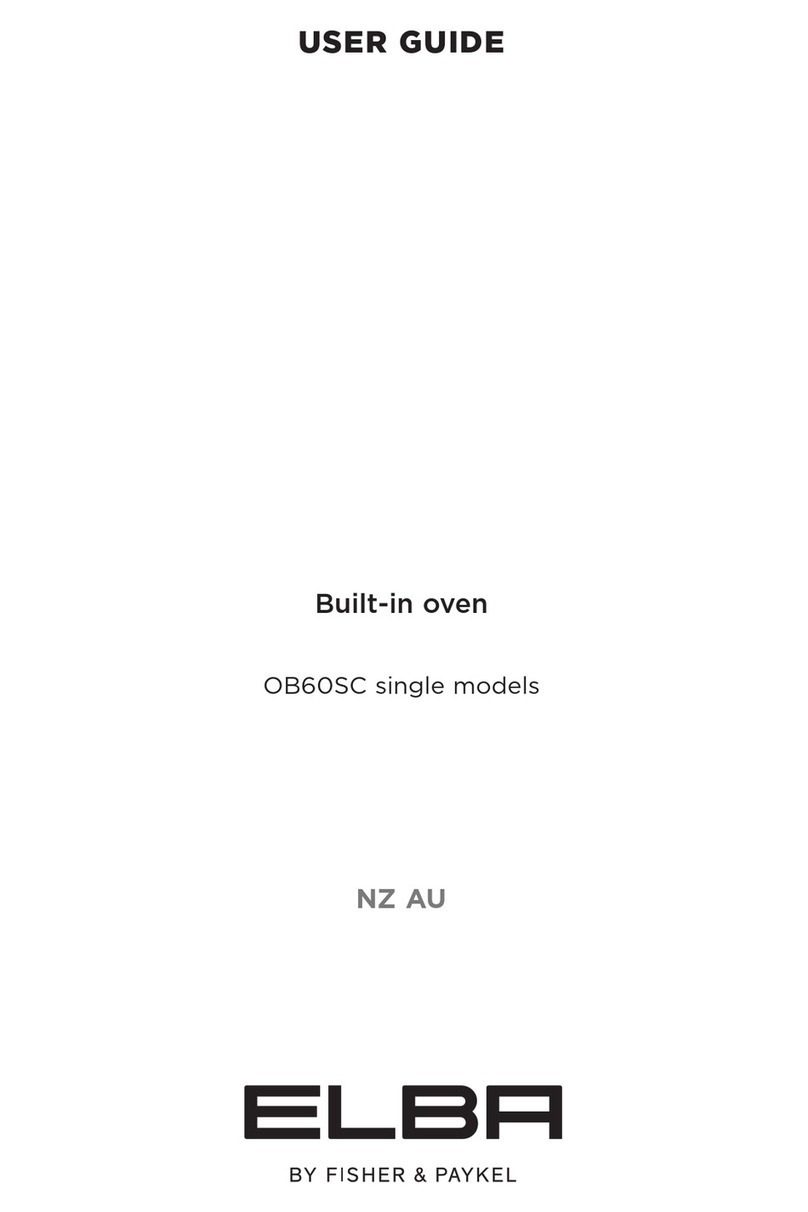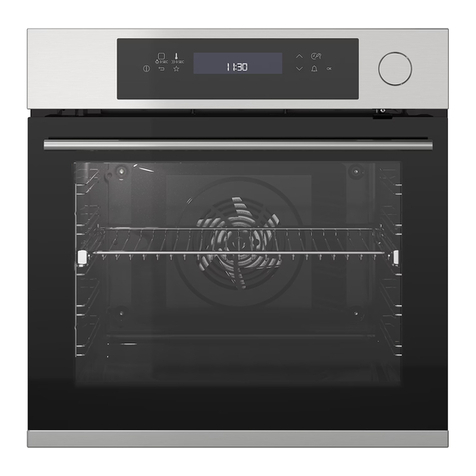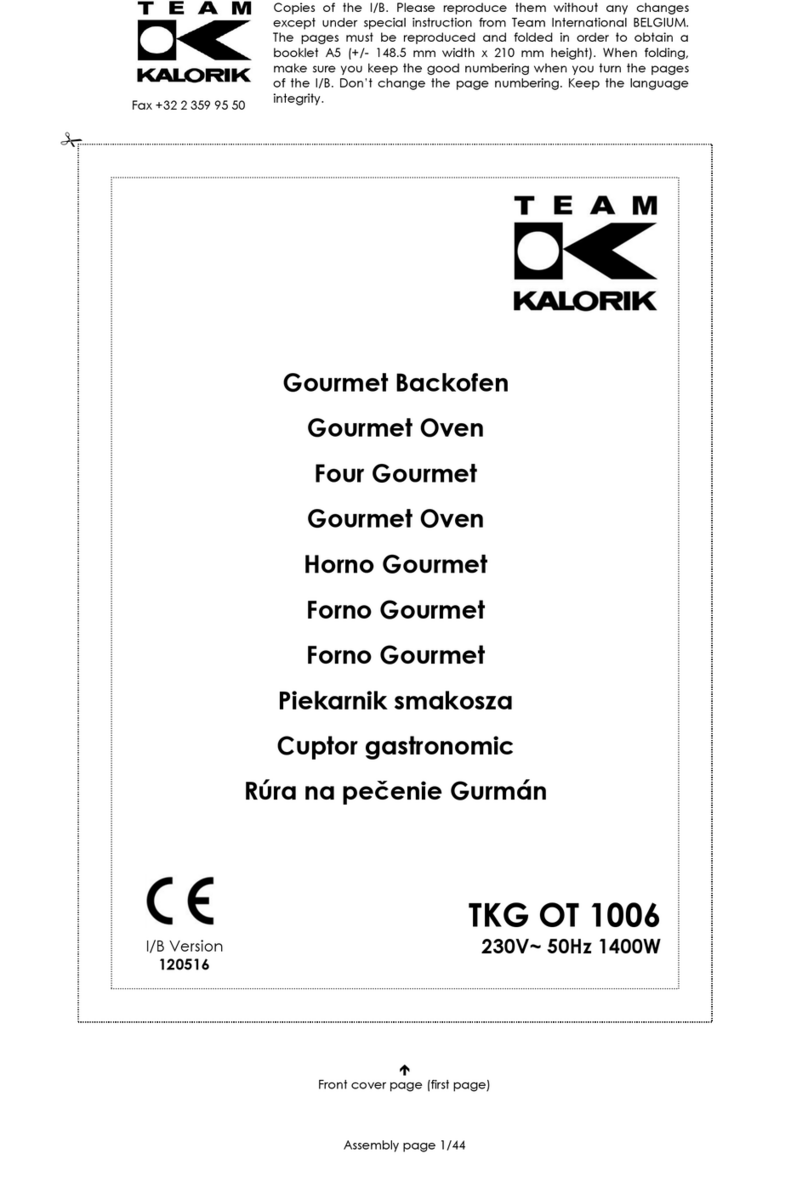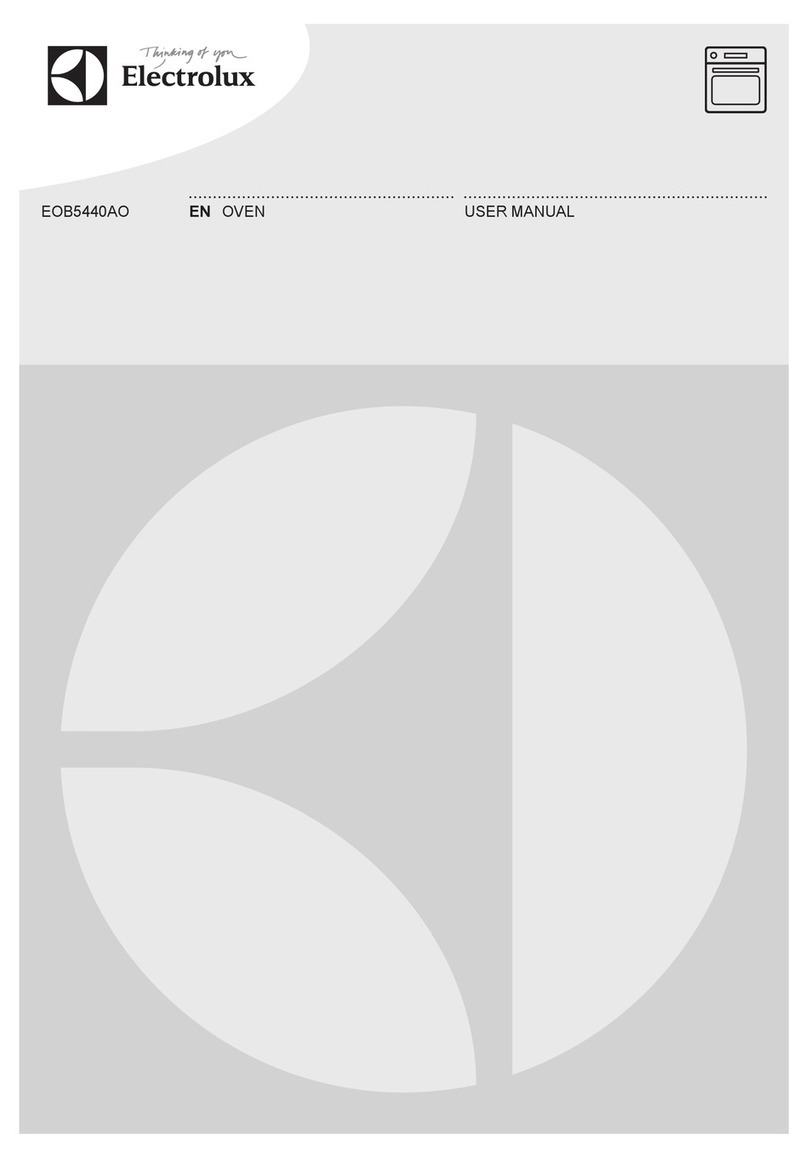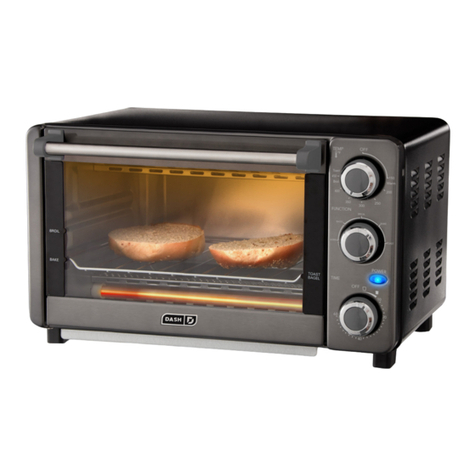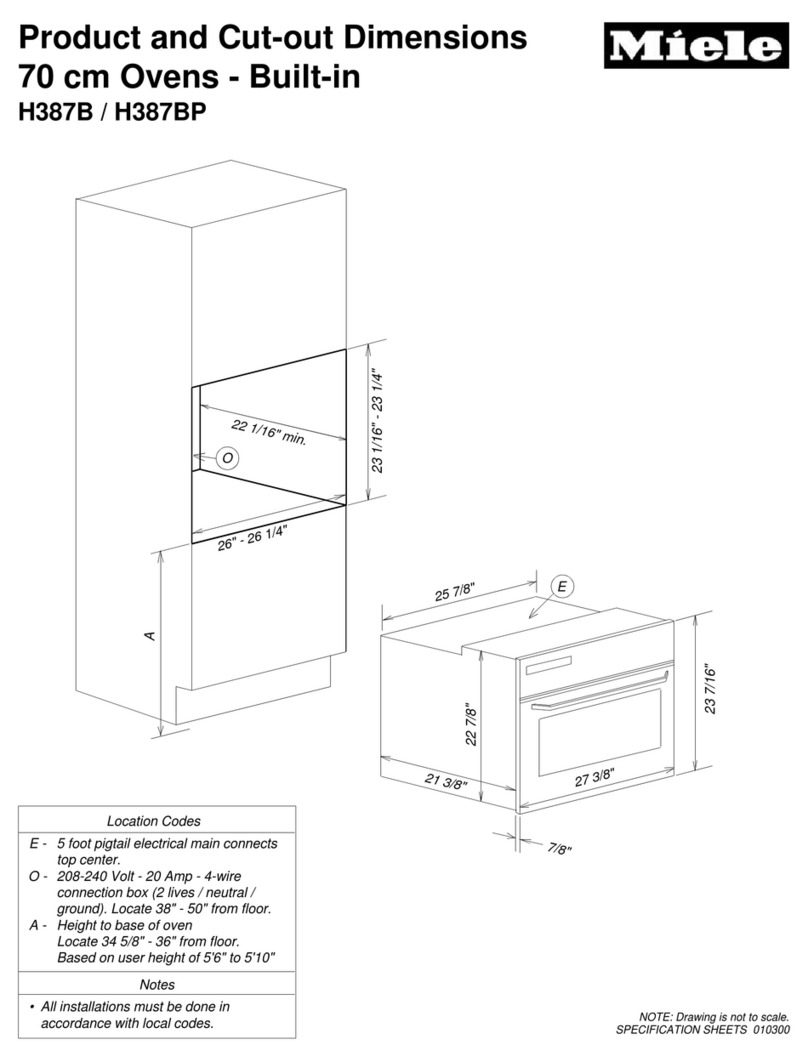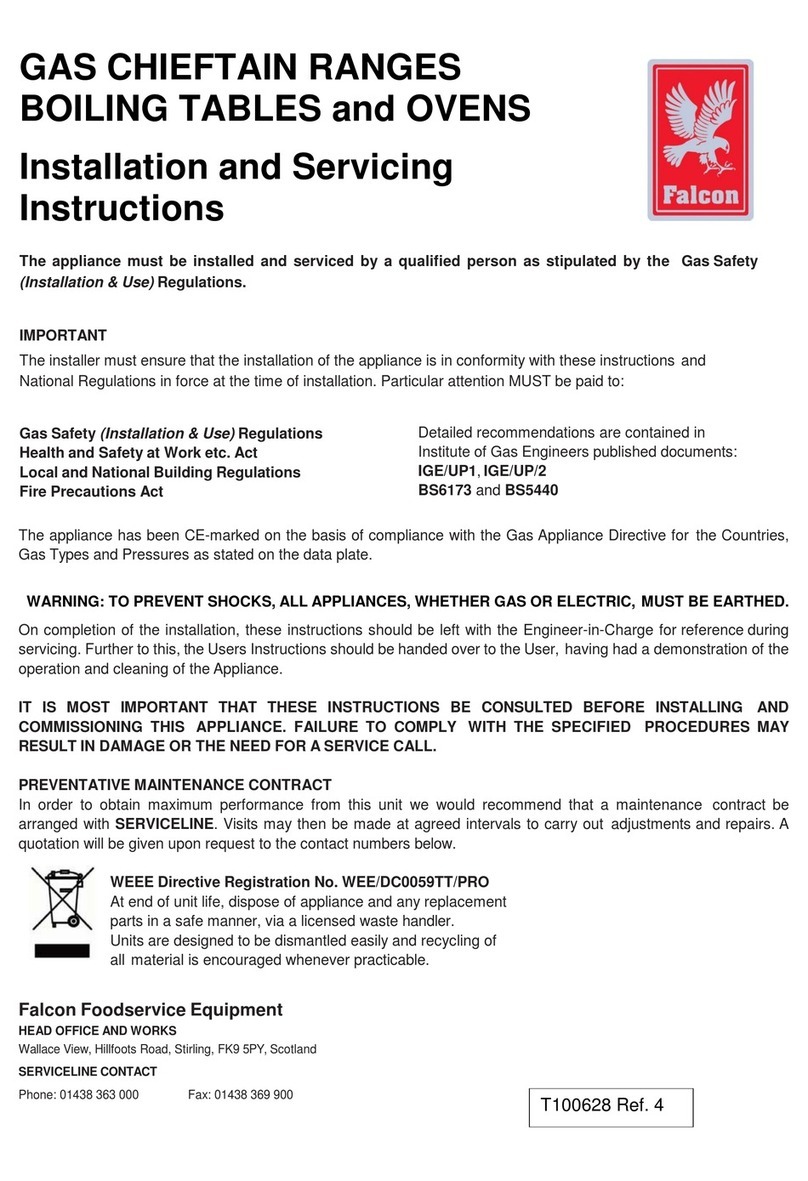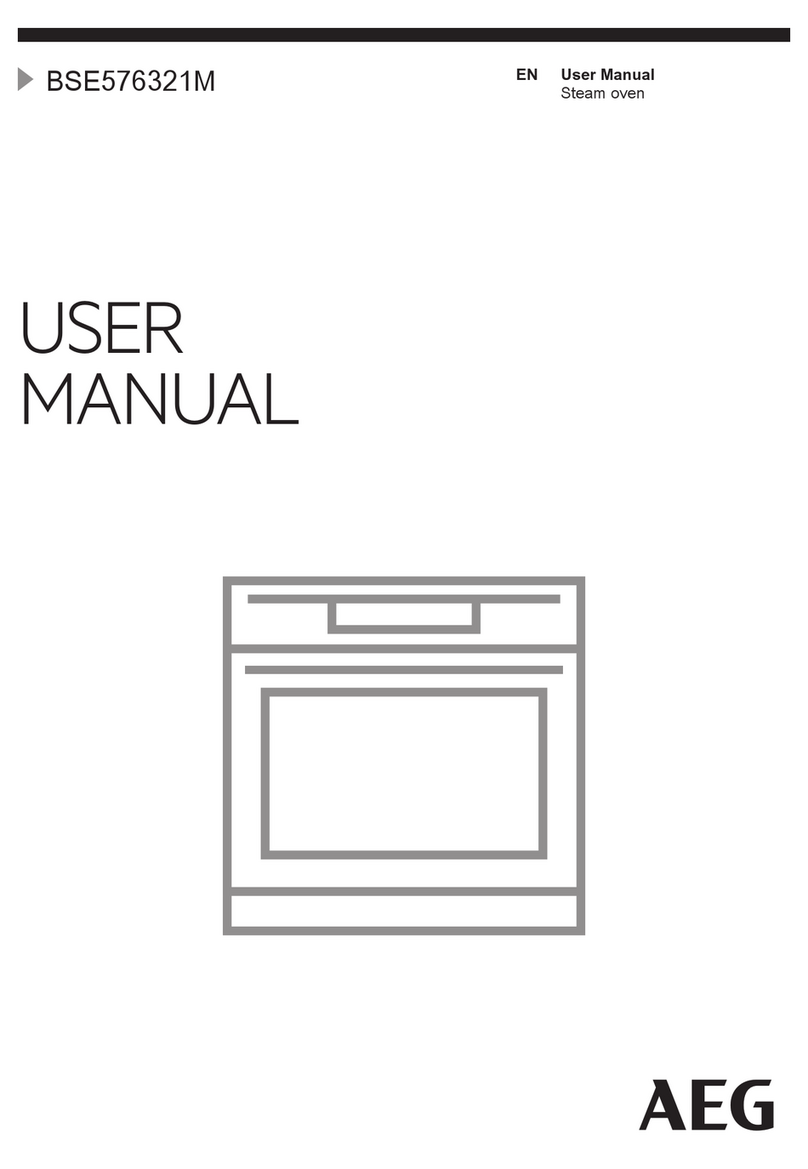FORNI FEM207SC Manual

- 1 -
LAST REVISION: 27/06/00 IMFOC 00201
INSTALLATION, OPERATION AND
MAINTENANCE INSTRUCTIONS
ANALOGUEELECTRIC-ELECTRONIC“COMBINED”OVEN
InaccordancewithstandardsEN60335partI
EN 60335 part II - 42
FEM67
FEM107
FEM207
FEM67SC
FEM107SC
FEM207SC

- 2 -
CONTENTS
SECTION DESCRIPTION PAGE
1. Warnings ............................................................................................................................................ 3
1.1 General warnings ............................................................................................................................... 3
2. Technical data ................................................................................................................................... 4
2.1 Electrical equipment ......................................................................................................................... 4
3. Installation diagrams ......................................................................................................................... 5
3.1 “Combined” electric oven FEM67/FEM67SC ................................................................................. 5
3.2 “Combined” electric oven with cabinet SFA - SFRU........................................................................ 7
3.3 “Combined” electric oven with stand SF.......................................................................................... 8
3.4 “Combined” electric oven FEM207/FEM207SC with stand SF2 .................................................... 9
4. Installation instructions .................................................................................................................... 10
4.1 Preparing for installation................................................................................................................... 10
4.1.1 Laws, regulations and technical directives ....................................................................................... 10
4.2 Positioning ........................................................................................................................................ 10
4.3 Cold water connection ...................................................................................................................... 10
4.4 Waste water outlet ............................................................................................................................. 11
4.5 Electrical connection ........................................................................................................................ 11
4.5.1 Earthing ............................................................................................................................................. 11
4.5.2 Equipotential system......................................................................................................................... 11
4.5.3 Power supply cable............................................................................................................................ 11
4.5.4 Transformation to operate with different electric power distribution networks ............................... 12
4.6 Other outlets ...................................................................................................................................... 13
4.7 Room ventilation .............................................................................................................................. 13
4.8 Presenting the oven to the user ......................................................................................................... 13
5. Use ..................................................................................................................................................... 13
5.1 User instructions: commissioning..................................................................................................... 13
6. Using the electronic oven ................................................................................................................. 15
6.1 Cooking selection ............................................................................................................................. 15
6.2 Vent valve in cooking chamber ........................................................................................................ 15
6.3 Humidifier ......................................................................................................................................... 16
6.4 Chamber light.................................................................................................................................... 16
6.5 Fan speed ........................................................................................................................................... 16
6.6 Cooking chamber temperature .......................................................................................................... 16
6.7 Cooking time and starting the oven ................................................................................................. 16
6.8 Core probe ......................................................................................................................................... 17
6.9 Cook & Hold ..................................................................................................................................... 17
6.10 Displaying and modifying cooking parameters ............................................................................... 17
6.11 Draining the boiler ............................................................................................................................ 18
6.12 Messages and alarms ......................................................................................................................... 18
7. Cleaning and maintenance................................................................................................................ 19
7.1 Cleaning ............................................................................................................................................ 19
7.1.1 Cleaning after cooking and at the end of the day............................................................................. 19
7.1.2 Descaling the boiler .......................................................................................................................... 19
7.1.3 Troubleshooting................................................................................................................................19
7.2 Maintenance...................................................................................................................................... 20
7.2.1 Replacing components...................................................................................................................... 20
A) Electric components and electronic card ..................................................................................... 20
B) Resistor ......................................................................................................................................... 20
C) Oven lamp..................................................................................................................................... 20
D) Oven door gasket.......................................................................................................................... 20
E) Cleaning solenoid valve filters .................................................................................................... 20
7.2.2 Yearly maintenance ........................................................................................................................... 21
7.2.3 Safety devices Equipment control and safety systems .................................................................... 22
7.3 Switching off in the event of equipment faults................................................................................. 22
7.3.1 Precautions if the oven is not to be used for a lengthy period.......................................................... 22

- 3 -
1. WARNINGS
-Installation,start-upandmaintenanceoftheovenaretobecarriedoutonlybyskilledpersonnelauthorizedbyourfirmor
by licensed installers.
-Readtheinstructionscontainedinthismanualcarefullyastheyprovideimportantinformationonthecorrectinstallation,
operationandmaintenanceprocedures.
- Store this manual carefully for future reference by the operators.
-Afterremovingthe packing,checktheintegrity of theequipment.
-Inthe eventofequipment failureortrouble, donotoperate theequipment,call professionallyqualifiedpersonnel.
- Packaging elements (plastic bags, polystyrene foam, nails, etc.) are potentially dangerous and should not be left within the
reachofchildren.
- Before connecting the equipment, make sure that the data reported on the plate correspond to those of the electric and water
supply networks.
- The plate is located on the front lower right side.
- The equipment is to be operated by specifically trained staff only.
-Thisequipment mustonlybeused forthepurposes forwhichitwas designed,i.e.cooking or warmingupfood; anyotheruse
is to be considered improper and therefore dangerous.
- Do not obstruct air vents or heat dissipation openings.
- Switch off the oven after use.
The manufacturer disclaims all responsibility for any inaccuracies in this booklet that may be due to typing or printing
mistakes.The manufacturer, moreover, reserves the right to make the modifications to the productitconsidersusefulor
necessary,withoutaffectingitsbasicfeatures.
In the event of the user or the installation technician failing to observe the instructions given in this manual, the Firm
disclaimsallresponsibilitythereofandcannotbeheldliableforanyaccidentsortroublecausedbysuchnon-observance.
1.1 GENERAL WARNINGS

- 4 -
2. TECHNICAL DATA
2.1 ELECTRIC APPLIANCES
•) With 3N AC 400 V 50 Hz. N.B. With 3N AC 380 V 50 Hz. the thermal power drawn is approximately 9% lower.
With3NAC 415V50Hz. thethermalpowerdrawn isapproximately9%higher.
MODEL
Standards
Outsidedimensions
Width
Depth
Height
Height
Netweight
Cookingchamberdimensions
Width
Depth
Height
Usefulvolume
CapacityNo.GrillesGN1/1-2/1
Oven load capacity
Guidec/cdistanceGN1/1
Tray depth
Power supply voltage
3NAC380....415V50Hz(or60Hz)
Externalresidual
currentdevice
Total absorbed electric power Motor
absorbed electric power
Convectionabsorbedelectricpower
Boilerabsorbedelectricpower
Power supply
Powersupplycable typeH07RN-F
Cable no. 5 wires Cross-section
Water supply
Softened water
Consumption
Steam generation
Steamelimination
* NB:1 bar=100 kpa
Waste water outlet
Max.temperature
Ovenperformance
Hotairtemperaturerange
Steam temperature range
Coreprobetemperaturerange
Timetoreach180-215°C
Consumptiontokeepaverage215°C
Fan speed
mm
mm
min.mm
max.mm
kg
mm
mm
mm
dm3
max.kg
mm
min.mm
A/ph.
kW
kW
kW
kW
min.mm2
(min÷max)bar*
l/h
l/h
Ømm
max.°C
°C
°C
°C
min.
kWh
min.g/min
max.g/min
EN60335-I
EN60335-II- 42
FEM67
FEM67SC FEM107
FEM107SC FEM207
FEM207SC
940
850
805
855
120
640
420
430
129
6/-
18÷24
60
20
x
16
9,5
0.5
9.0
6.0
1.5
G3/4”
0.5÷4
9
90
40
100
20÷270
20÷100
20÷99
4/5.0
1,2
1400
2800
940
900
1050
1100
175
640
420
670
199
10/-
30÷40
60
20
x
32
15.6
0.6
15.0
12.0
2.5
G3/4”
0.5÷4
18
140
40
100
20÷270
20÷100
20÷99
3.5/4
1,4
700
1400
1340
980
1045
1095
330
640
860
670
322
20/10
60÷80
60
20
x
40
22.3
0.7
21.6
15.0
6.0
(2X) G 3/4”
0.5÷4
22
140
40
100
20÷270
20÷100
20÷99
5.5/6
1.8
700
1400

- 5 -
3. INSTALLATION DIAGRAMS
3.1 “COMBINED” ELECTRIC OVEN FEM067/FEM67SC
D) Water outlet Ø 40 mm
F) Vent pipe Ø 50 mm
G) Powersupply cable entry
B) Softened water inlet G 3/4”
H) Descaling agent inlet

- 6 -
“COMBINED” ELECTRIC OVEN FEM107/FEM107SC
D) Water outlet Ø 30 mm
F) Vent pipe Ø 40 mm
G) Powersupply cable entry
B) Softened water inlet G 3/4”
H) Descaling agent inlet/
Safety valve

- 7 -
3.2 “COMBINED” ELECTRIC OVEN WITH CABINET SFA - SFRU
FEM67
FEM67SC
FEM107
FEM107SC
D) Water outlet Ø 40 mm
F) Vent pipe Ø 50 mm
G) Power supply cable entry
B) Softened water inlet G 3/4”
H) Descaling agent inlet
D) Water outlet Ø 30 mm
F) Vent pipe Ø 40 mm
G) Power supply cable entry
B) Softened water inlet G 3/4”
H) Descaling agent inlet/Safety valve

- 8 -
3.3 “COMBINED” ELECTRIC OVEN WITH MOUNTING SF
FEM67
FEM67SC
FEM107
FEM107SC
D) Water outlet Ø 40 mm
F) Vent pipe Ø 50 mm
G) Power supply cable entry
B) Softened water inlet G 3/4”
H) Descaling agent inlet
D) Water outlet Ø 30 mm
F) Vent pipe Ø 40 mm
G) Power supply cable entry
B) Softened water inlet G 3/4”
H) Descaling agent inlet/Safety valve

- 9 -
3.4 “COMBINED” ELECTRIC OVEN FEM207/FEM207SC WITH MOUNTING SF2
D) Humidifierwaterinlet
and steam generator G 3/4”
E) Water outlet Ø40 mm
F) Coldwaterinlet
eliminating steam G 3/4”
B) Top steam outlet
adjustable Ø 50 mm
G) Powersupplycableentry
A) Steamgenerator weight valve
(descaling agent inlet)

- 10 -
4. INSTALLATION INSTRUCTIONS
Installationandadjustmentoperationsaretobecarriedoutbyqualifiedpersonnelaccordingtothenormsinforce.
(Seetechnicalspecificationtablespage 4).
WARNINGS:
- If the oven is installed against a wall, the wall needs to withstand temperatures of 80°C and must be incombustible.
- Inlets (water and electricity) and outlets (waste water, steam etc.) are signalled by dedicated tags.
- The top of the oven is not to be used to store goods!
4.1 PREPARING FOR INSTALLATION
Beforeproceedingto installation, removetheprotective plastic filmandeliminate any adhesiveresiduesby means ofasuitable
product for cleaning stainless steel.
4.1.1 LAWS, REGULATIONS AND TECHNICAL DIRECTIVES
Thefollowing regulationsmustbeobservedduringinstallation:
-Currentaccident-preventionregulations.
-”Electricsystem installation”standards.
-Theregulationsof the electricity board.
- The regulations of the water board.
-Local”municipal”norms on the drainageofwastewater.
- Health regulations.
-Italianlawno.4605/03/1990.
4.2 POSITIONING
Place the oven under a ventilation hood to make sure all vapours are extracted.
Installtheoven horizontally andcheckthe correct positioningbymeans ofalevel;rotate levellingfeettoadjust.
The oven may be installed on its own or in a group of several elements; but make sure it is not placed next to combustible
objects.
- Never obstruct the air vents and heat dissipation openings of the oven.
- The electric cable must never be subject to traction.
-Provide clearance of1/2metre ontherightfor maintenance.
4.3 COLD WATER CONNECTION
(SOFTENED)
Waterpressure:min. 50kPamax. 400 kPa(0.5<PH2O<4bar).
The water inlets must be connected to the softened supply
networkata maximumtemperatureof 50°Cbymeans of
shut-off valves, to be closed when the oven
is not being used or for maintenance work.
The water is used to condense the vapours in the
waste water outlet, to supply the humidifier and
to generate steam; between the shut-off valve and
the oven connection pipe, there must be a mechanical
filter so as to prevent any ferrous waste getting
insidethatcould overtimecause oxidationofthe
oven.
If the hardness of the water is greater than 5-7°Fr, it is
necessary to install a softener with automatic
regeneration,tobe positioned afterthemechanical filter.
As regards the flow rate per hour of the softener, refer to the Table on page 4.
REAR WATER
CONNECTION

- 11 -
4.4 WASTE WATER OUTLET
The water outlet “1” must lead
to an open siphon “2” so as
to allow no contact between the outlet pipe
of the oven and the collecting siphon
as per the current local health regulations
and for the oven to work properly.
To prevent bad smells and waste water getting
back into the oven, after the open siphon there
should be a normal siphon “3”.
The drain pipe is to be manufactured
withmaterialsabletowithstand temperatures
of100°C.
N.B.A“closed”connection to thechannel
is not permitted!
To condense outlet vapours of the oven FEM207/FEM207SC
connect cold water supply to the solenoid valve C as
shown in the figure.
The water pressure must be between
50and400kPa(0.5 <PH2O<4bar).
4.5 ELECTRICAL CONNECTION
- Theelectricalconnectionmustbe carried out byqualifiedauthorizedpersonnelonly, in compliance withtheregulationsin
force.Check thedatareportedinthetechnicaldataTableon page4 ofthismanual,ontheadhesiveconnectionlabelon page
11andinthe wiringdiagram.Theconnection envisaged isfixed.
IMPORTANT:Amulti-polarmains cut-off device mustbeprovidedupstream from each oven,withacontact opening gap of
at least 3 mm.
For example:
- a manual switch of suitable capacity, equipped with fuses
- residual current device.
4.5.1 EARTHING
It is vital to earth the oven.
Connect the terminals marked by the symbols ( ) positioned on the line-in terminal block to an efficient grounding
complying with the regulations in force.
CAUTION: NEVER CUT THE GROUNDING CABLE (yellow-green)
THE MANUFACTURER DISCLAIMS ALL RESPONSIBILITY IF THESE SAFETY STANDARDS ARE NOT
COMPLIED WITH.
4.5.2 EQUIPOTENTIAL SYSTEM
The oven must be included in an equipotential system whose efficiency must be checked according to the
standards in force. The screw marked by the ”Equipotential” label is near the terminal block on the base.
4.5.3 POWER SUPPLY CABLE
The oven is supplied without a power cable. The specifications of the power supply connection flexible
cable must match or be superior to those of the cable with rubber insulation H07RN-F.
As regards the cross-sections of cables, refer to the table on page 11. Introduce the cable through the cable clamp
andsecureitfirmly. During operation,thepowersupplyvoltage shouldnotdifferfromthe voltage ratingby +/-10%.
INDIRECT WASTE WATER OUTLET THROUGH
OPEN SIPHON

- 12 -
4.5.4 TRANSFORMATION FOR OPERATION WITH DIFFERENT ELECTRICAL
NETWORKS FOR DISTRIBUTION
Equipmentismanufacturedtooperatewiththefollowingvoltagevalues: 3NAC380...415V;3AC220....240VorAC220....240
V50Hz.(in case of60Hz. power supply, requesttheappropriate kit).
If it is to be connected to one of these voltages, proceed as follows:
•Removethe rightpanel.
•Connectthepower supplycabletothe terminal blockaccordingto the mainsvoltage,followingthe wiring diagramandthe
adhesiveconnectionlabel placed neartheterminal block.
Fastenthe cable-clamp firmlyafterinserting a sufficientlengthof cable.
CONNECTIONS TO THE DIFFERENT ELECTRICAL NETWORKS
TYPEOFVOLTAGE
3NAC380...415V50Hz
3AC220...240V50Hz
AC220...240V50Hz
WIRINGDIAGRAM
DRAWING No.
15.2
24.5
41.3
Imax.
A/f No.cables
mm2
MODEL FEM67
FEM67SC
PE (Earth) yellow-green
N (NP) blue
L3 (T) black
L2 (S) black
L1(R) brown
3N AC 380...415 V 50 Hz
PE (Earth) yellow-green
L3(T) blue
L2 (S) black
L1(R) brown
3 AC 220...240 V 50 Hz
PE (Earth) yellow-green
N (NP) blue
L1(R) brown
AC 220...240 V 50 Hz
5x 1.5
4x 2.5
3x 10
FEM107
FEM107SC
11344
FEM207
FEM207SC
11346 12402
Imax.
A/f Imax.
A/f
No.cables
mm2No.cables
mm2
5x 2.5
4x 6
-
5x 6
4x 10
-
24.3
39.9
-
33.0
57.0
-

- 13 -
4.6 OTHER OUTLETS
Fornoreasonmay the food vapourventorwaste water outlet oftheappliancebe closed, blockedorchannelledtogether with
other pipes.
4.7 ROOM VENTILATION
It is necessary to have plenty of air coming into the rooms to take the place of the volume of air expelled through the flues,
approximately 30 m3/h. Air should be introduced into the room without causing any dangerous draughts or being directed
towardsthe operators.Adjust theventilationoutletflapsproperly.Regularlycleantheintakefan,filtersandpipetopreventthe
fans getting clogged. Never use flammable solvents to clean the filters. Periodically check the outlet for any damage or
obstruction.
4.8 PRESENTING THE OVEN TO THE USER
Explain the operation and use of the oven to the user with the aid of the instructions booklet.
Leave the instructions booklet with the user and explain he needs it for further reference.
A technical service and maintenance contract should be recommended for the user.
5.1 USER INSTRUCTIONS: COMMISSIONING
CAUTION: For supervised operation only.
Afterpositioningand connectingtheoven, theinsideis tobecleaned thoroughly.Spraythe insideoftheoven withaspecific
degreasing product (make sure not to use products that can leave residues that smell in the oven). Select the ”convection”
function,a temperatureof 90°Candahumidityof40%,thenoperatetheovenfor 30÷40minutes.Turntheovenoffanddrywith
acloth.
Thecombinedovenbelongstothesecondgenerationofconvectionovens.Itisaconvectionovenandapressurelesssteam oven
combined into one. The steam is generated inside the oven and set in circulation by a powerful fan. Any food can be prepared in
theideal mannerwithasingleoven.Thecombinedovenmaybeusedeverydayforanykindofcooking.Thanks toits numerous
features,itcanbeusedforsteam cooking,gratinating,stewing,browning,grilling,braising,pre-cooking, reheatinganddefrosting.
Utilization:
1) CONVECTIONOVEN:like aconventionaloven, butwiththewell-knownadvantage offorced-ventilation.
2) STEAM OVEN pressureless: to steam-cook, defrost and heat.
3)COMBINED:forall foods thatneedtobe cooked verydifferentlywithout having to changeoven.
Forexample: -steaming and thengrilling
- browning and then steaming
-steamingand latergratinating
- cooking and roasting meat, baking bread and pastries
-steamingat100°C
- second cooking
-slowcooking50/97°C
-boiling,braising androasting
- defrosting and warming up
- defrosting, heating and cooking different products at the same time
CAUTION: Never use coarse salt since it would not dissolve completely.
In the long run, undissolved salt can cause corrosion at contact points.
Lowertemperaturesthan staticovensareused, theymaybe from 20to30°C lowerdependingon the typeoffood tobecooked.
Two cooking cycles are possible to have different temperatures and humidity levels.
Makesurethat the foodisplaced soastoavoid anymodificationofthe balancedaircirculation inside thechamber(max. load
approx.4kg/GN1/1).
The dual speed allows very high performance in the cooking of pastries.
Warning:whenthe ovenishot,open thedoorcautiouslysince theaccumulatedsteamcanscald.
Hotsurfacesoftheoven:door,glassandfront.
5. USE

- 14 -
TAB.1
ELECTRONIC COMBINED OVEN INSTRUCTIONS - CONTROL PANEL
- 1 VALVOLA SFIATO -
-7RAFFREDDAMENTOCAMERA-
-6RIGENERAZIONE-
- 5 MISTO -
-11MANOPOLATIMER -
-12UMIDIFICATORE-
-15 LEDSONDE BOILER- - 16SCARICO BOILER-
-17SONDACUORE-
-18 MANOPOLATEMPERATURA-
-14 DOPPIAVENTILAZIONE-
-13 ILLUMINAZIONECAMERA-
-10DISPLAYTIMER-
-19 MANOPOLASELETTORE -
-2CONVEZIONE-
- 3 VAPORE -
-4 VAPORETERMOSTATO-
-8DISPLAYTEMP. CAMERA-
-9 MANOPOLATEMPERATURA-

- 15 -
6. USINGTHEELECTRONICOVEN
6.1 COOKING SELECTION
Theselectionismadebyturningtheselectorontooneofthesixpositionscorrespondingtothedifferentcookingmodes:the
respectiveLEDs(2,3,4,5,6,7)flashand,afterafewseconds,thefunctionisaccepted.Thecontrolpanelthencomesonandthe
ovenispreparedforcooking:theboilerisloadedandthenpre-heatingtakesplace.Itisthereforeadvisabletoturntheselector
at least ten minutes before starting cooking in order to have the oven ready.
CONVECTIONCOOKING
From 20°C to 270°C this is the fastest cooking method. It offers the opportunity of combining different cooking
methods without altering the flavour, thanks to the hot air evenly distributed in the chamber by a fan. Ideal for
roasting,gratinating,toastingandgrilling.
STEAMING100°C
Themainadvantagesofsteamingcomprisemaintainingnutritionvalues,greaterefficiencyandlowerweightloss,
thepossibilityofmultiplecookingandtheconsiderablesavingsinsauces.
THERMOSTATTEDSTEAMING
From50°to99°Citpermitscookingfoodsthathavealreadybeenprocessed,portionedandvacuumpackaged.The
mainadvantagesderivingfromusingthistypeofcookingcompriseprogrammingandthebatchingofwork,longer
preservationofcookedfoods,virtuallynoweight lossandnutritionvaluesaremaintained.
COMBINEDCOOKING
From100°Cto270°C this cookingmodecombinesthebenefits of steamandconvection.Itcan cut cookingtime
downto30%evenfortraditionallydifficultfoodssuchaspotatoes,carrots,etc.Itispossibletosteamfoodsandthen
gratinatethem,orglazethemormakethemcrispy.Combinedcooking,thankstotheintensehumidityandheatof
theair,decreasestheweight loss of traditional dishes (roasts, hams, etc.).
AUTOMATICALLYLOWERINGOVENTEMPERATURE
Ifsteamingor thermostattedsteamingareselected whentheoven isstillhotdue topreviouscookingathightemperature,
waterisinjectedintotheovenandsteamisnotgeneratedsoastoquicklylowerthetemperatureandpreventspoilingproduct
putintoa chamberthatistoohot.
WARMING
This type of heating makes it both possible and cost-effective to warm up refrigerated products. It is done in
combinedmode,160°C,lowspeed.Itisrecommendedtokeeptheventvalve1open.
6.2 COOKING CHAMBER VENT VALVE (1)
Thislevermakesitpossibletoopenandclosethecookingchamberventvalvesoastoadjust theamountofsteam
leavingthecookingchamber.
VENTILATIONTOLOWEROVENTEMPERATURE
Thisisusedtolower the temperatureofthecookingchamberquickly. In thisfunctionthefanturnsalso with the
dooropen:tohavethistype ofoperation,close thedoor,settheventilationfunction,proceedbystartingtheoven,
settingatime,thenopenthedoor.

- 16 -
6.4 OVEN LIGHT (13)
6.5 FAN SPEED (14)
Twospeedsareavailable: a highonefor fast cookingandalow one fordelicatecooking or steaming.TheLEDsat the corners
of the button indicate which speed has been selected.
6.6 OVEN TEMPERATURE (8)
6.7 COOKING TIME AND STARTING THE OVEN (10)
During oven operation, the display 10 shows the time passed. On reaching the set value, the oven stops, emits the end-of-
cooking sound for 1 min. and displays the message “End”.
Tocancelthis message(orto terminatebeforethe end-of-cookingsound),in ordertoset anewcooking time,youneed topress
theclockbutton(10).
In the case of continuous operation, to end cooking you need to zero the cooking time or turn the selector onto Ø.
Payattentionto thesepoints:
1)Ifsteaming,thermostattedsteaming, combined cooking or warming areselected,theovenwill not start until theboilerhas
finished loading, it will stay on standby (in other words as long as LED 16 is on).
2)Inthe100°C steam function,thefan will notturnuntilthe chamber reaches80°C.This makes itpossibletoput the product
inside even when the oven is closed without having any movements of air that can affect the cooking.
3) The oven is equipped with a cooling fan for the internal components. It starts when the oven is switched on and stops
approximatelytenminutes aftertheoven hasstoppedworking.
Button13switchestheovenchamberlightonoroffat anytimeas preferred.
TWIN FAN SPEED
Thisfunctionmakesitpossibletohalvetheamountofair inthecooking chamberasrequiredfordelicatecooking,
whichneedsless airflowwhile ensuringhomogeneouscooking.Thiscontrolthereforemakes itpossibletousea
single oven for two preparations.
Afterselectingthedesiredcookingfunction,display 8 will show a pre-settemperature.Tochangeityouneedto
turnknob9clockwisetoincrease,anticlockwisetodecreaseit.
Duringovenoperation,display8showsthetemperatureinthecookingchamber.
Toseta cookingtimeandstart theovenyouneed toturnknob11:afew secondsafter lettinggo oftheknob,theoven
will start up. Turning the knob clockwise makes it possible to set a cooking time. Whereas, to have continuous
operation you need to turn the knob anticlockwise until the appearanceofCont onthedisplay10.
6.3 HUMIDIFIER (12)
Caution:Inthesteaming,thermostattedsteamingandcombinedcookingmodes,thehumidifierisdisabledsoitisnotpossible
to add more water into the chamber when the boiler is already in operation.
Itispossible toadjustthe percentageofmoistureinthecookingchamber. Itisessentialtoobtainproductswith a
lowmoisturecontent,suchasbread,biscuitsandcakes, soft items.
Thehumidifierisalsousedtopreventroastsfromburningorlosingalotoftheirliquid.Pressingthisbuttononce
(leftLEDon)introducesapproximately 4l/hofwater.Pressing itagain (rightLEDon)introduceswater continuously
(approximately18l/h). Toswitchoff thehumidifier,press thebuttonagain (LEDsoff).

- 17 -
Duringoperationwiththecoreprobe,theminutecounterwillinanycasedisplaythetimepassed.
Theinnerprobeonlystopscookingonreachingthetemperatureinsidethefoodpre-setonthespecific display.
Thetemperaturerangethatcanbeadjustedinthe displayis20°C -99°C.
Caution: It is anyhow always necessary to set the temperature and cooking process (e.g. convection, steam, combined or
convectionwith humidification)in thecookingchamber.If99°CisexceededthedisplaywillshowOvl(Overflow).Attheendof
cookingwiththe core probe,cook& hold triggersautomatically(see par.6.9).
If at the start of cooking the core probe is hot because of pre-heating the oven (when the core probe was in the cooking
chamber),display 18will flashuntil theactual temperatureofthefoodisdisplayed;onlythenwillcookingcommence.
Tocookwiththecoreprobe,firstofall turn the selector onto one ofthefunctions.Pressingthispush-buttonwill
light up the core probe temperature display, showing a set temperature, and the minute counter display will be
deactivated.Setthe desiredcoretemperaturewithknob18.A fewsecondsafterlettinggoofthe knobtheoven will
startandthetemperatureinsidethefoodwillbedisplayed.
6.8 CORE PROBE (Only for models -SC)
For many foods (for instance roast-beef, pâté, fatty roasted meat, etc.) the temperature inside the product is very important.
Withtheinnerprobe, it ispossibleto switch offtheovenat the righttime,that is whenthedesiredtemperature (previously set
on display 17) has been reached.
You do not need to set the cooking time because, by setting the temperature on the thermostat of the ”inner probe”, the timer
isautomaticallyexcluded.
The thermostat shows the temperature inside the product.
Thecookingtime isobtainedfromthe”inner probe”thermostat.You canusethe ”innerprobe”cookingprocesstogether with
alltheother cooking processes(forinstance, steaming, convectioncooking,mixed cooking andsoon).
Here is a table giving the temperature to set:
Inner temperature °C Application
40÷45 Rawmeat
45÷50 Raremeat
50÷70 Redmeat
75÷95 Well-donemeat
- Insert the probe into the most representative piece.
-Placethe piece ofmeatcontainingthe core probeinthe geometrical centreofthe cooking chamber.
- Make sure that the probe tip is as much in the centre of the piece to be cooked as possible.
6.9 COOK & HOLD
Cook & hold is only activated in the core probe cycle. At the end of cooking, the product is kept hot without its temperature
fallingunder 70°Candtherebyexcludingtheriskofbacteriaspreading.
At the end of cooking with the core probe, the oven automatically goes onto hold, shown on display 10 with the flashing
message Hold. If after ten minutes the oven is not switched off and the product taken out, the holding process shown by the
steady message Hold commences. Pressing the clock button (10) displays the time passed since the start of holding. During
holdingtheoven automaticallyheatsup if thecoretemperature fallsunder70°C.
To end holding, you need to turn the selector onto Ø.
6.10 DISPLAYING AND MODIFYING COOKING PARAMETERS (8, 10, 17)
DISPLAY:Justpressoneof thebuttons8,10,17 (LEDon)andtherelevant displayswillshowthechamber temperatureandthe
settimeor thesetcoretemperature. Waitfora few sec.andthe displayswillgo back toshowingthe chambertemperature,time
passed or core temperature (LED off).
CHANGE.While theovenisoperating,tochangethesettemperatureortimeorcore temperature,you needtopresstherelevant
button (LED on) and turn the knob: after a few seconds the new parameter will be accepted (LED off).

- 18 -
6.11 DRAINING THE BOILER (16)
Caution: After manually draining the boiler you need to switch off the control panel selector on Ø; otherwise, the boiler will
no longer be loaded. Afterwards, switching the control panel back on, turning the selector, the valve will automatically close
and the boiler will start loading.
AUTOMATIC BOILER DRAINING + WASHING
After approximately 5 hours of the oven not working, the boiler is automatically drained and rinsed with a second load and
a second draining.
Caution: For the oven to do this, you need to leave the multi-polar switch on and the water shut-off valves upstream from the
oven open.
6.12 MESSAGES AND ALARMS
Service messages
Door : door open
Cont : continuous operation
Hold flashing: waiting to hold
Hold steady: holding in process
End : cooking has ended.
Alarm messages
H20 : Not enough water in the boiler. See if the water valve is shut or if there is no water in the supply network.
To cancel the message and restart loading the boiler, press the clock button (10).
P1 no : Chamber temperature sensor broken or disconnected.
P2 no : Core probe broken or disconnected (it is still possible to continue using the oven without the core probe).
P3 no : Boiler pre-heating probe disconnected.
IMPORTANT: In the case of the last three messages, it is recommended to call a technician to restore normal conditions.
Button16makesitpossibletodraintheboilermanually(onlywhentheovenisnotinoperation).WhentheLED
ison,thevalveisopen,whenitis off,thevalve isshut.
7.1 CLEANING
CAUTION:
Neverwashthe outsideofthe ovenwithdirectorhigh-pressurejetsof waterasthiswoulddamagetheelectriccomponentsinside.
The oven needs cleaning every day as a matter of hygiene and to prevent its operation getting impaired over time.
7.1.1 CLEANING AFTER COOKING AND AT THE END OF THE DAY
Use a specific degreasing product to clean the oven (do not use corrosive or chlorine-based detergents). It is recommended to
follow the detergent manufacturer’s directions.
1) Carry out the cleaning program as described in par. 6.5.
2) Then open the oven and wipe it with a damp cloth
or dry it with hot air at 100°C.
3) Take out the filter and the removable parts and wash them
fully open.
4) Rinse the oven and accessories with water, possibly
using the external handshower (optional on all
versions).
5) Dust the door gasket regularly with talcum powder,
at least once a week.
6) See that the outlet is cleaned regularly and
check it is clear.
FEM207-FEM207SC
7. CLEANING AND MAINTENANCE

- 19 -
7.1.3 TROUBLESHOOTING
THE OVEN DOES NOT COOK EVENLY
* The products to cook have been pressed too close to each other.
You should always check there is good air circulation between the products.
YOUR PRODUCT IS DRY AND IS UNFIT FOR CONSUMPTION
* Check whether the humidifier is working and whether the temperature is the right one for your product.
7.2 MAINTENANCE
Before doing any maintenance work you must cut off the electricity and water supplies to the oven.
All the oven components, being subject to wear, are easy to reach from the right-hand side.
7.2.1 REPLACING COMPONENTS
CAUTION: Have this done by a skilled technician only!
Disconnect the electricity and water supplies.
Follow the wiring diagram.
A) Electric components and electronic card
All the electric components and the electronic card are on the right-hand side of the oven.
In order to replace them, you therefore need to take off the right-hand side panel.
This is why the oven should be installed with sufficient clearance on the right-hand side.
B) Resistor
To replace the resistor:
- Remove the rear panel.
- Open the screen inside the oven.
- Detach all the wires.
- Remove the resistors.
- Fit it all back together in reverse order to the above
and using the wiring diagram.
C) Oven lamp Tab.3
- Remove both screws (1).
- Remove the frame (2) with glass (3).
N.B. Check that the silicone rubber gasket is not damaged.
- Replace the oven lamp (4).
- Fit it all back together in reverse order to the above.
7.1.2 DESCALING THE BOILER
Every 7 - 15 days it is advisable to carry out descaling.
- Drain the boiler by pressing the
button then close it again.
-Prepare asolutionofdescalingliquidfollowing
the manufacturer’s directions.
Quantityofdilutedsolution:
FEM67=4l
FEM107=5.5l
FEM207=5.5l
- Lift the cap 1 (Tab.7) and pour the solution into the boiler.
-Operatethe ovenwiththe steamfunctionfor approximately
2-3minutestopre-heatthe solution.
-Lettheliquidact approximately10'then drainthegenerator.
- Switch the control panel off and back on again by turning the
selector so as to load the boiler. When loaded, drain it again.
N.B. For the steam generator to function properly
the water softener requires thorough maintenance
in order to avoid scale. TAB. 7

- 20 -
D)OvendoorgasketTab.8
- Take the gasket out of its seat.
- Clean the seat of the gasket of all
trace of dirt.
- Place the new gasket in its seat (2),
seal the 4 corners with a silicone-based
mastic.
E) Cleaningsolenoidvalvefilters
-Removethe rearpanel.
- Remove the water supply pipe.
- Take out the filter and wash it thoroughly.
-Fititallbacktogether.
TAB. 8
7.2.2 YEARLY MAINTENANCE
This is only to be done by an authorized, skilled technician!
1) Check the seal of the door gasket.
2) Check the seal of the gaskets of the door double-glazing.
3) Check the seal of the lamp-holder glass gasket.
4) Removing and thoroughly cleaning the fan. Open the screen by pushing on the pins and turning them through 90°C.
Remove the fan and clean it thoroughly (left-hand nut).
Fit the screen back on, putting the pins back in their original positions and pushing them
fully in so you hear them click home.
5) It is also recommended to oil the seal of the driving pin passage.
6) Descale the probes, taking care not to swap the wires over.
This manual suits for next models
5
Table of contents
Other FORNI Oven manuals
Popular Oven manuals by other brands
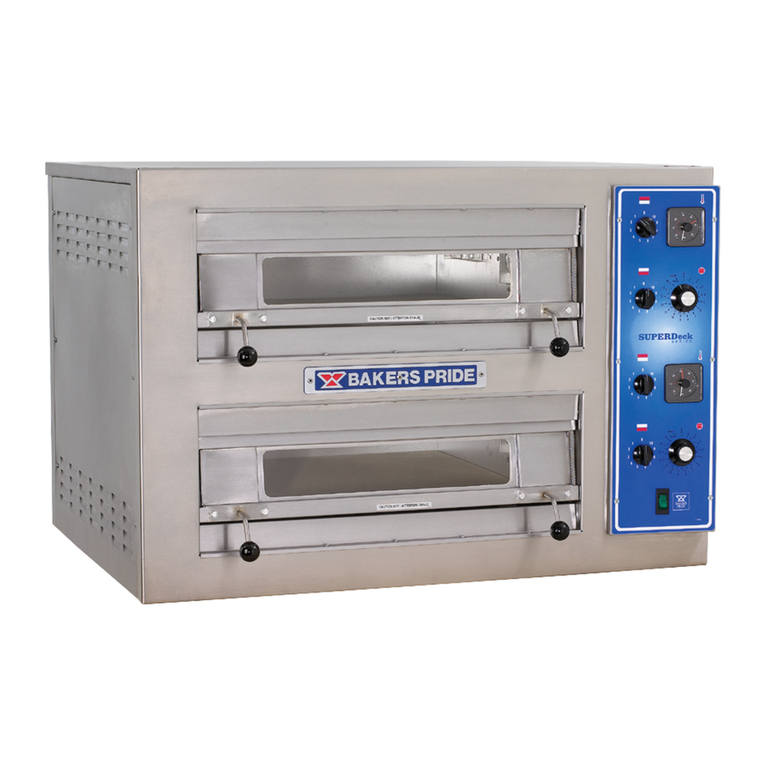
Bakers Pride
Bakers Pride EP-2-2828 Single Installation and operating instructions
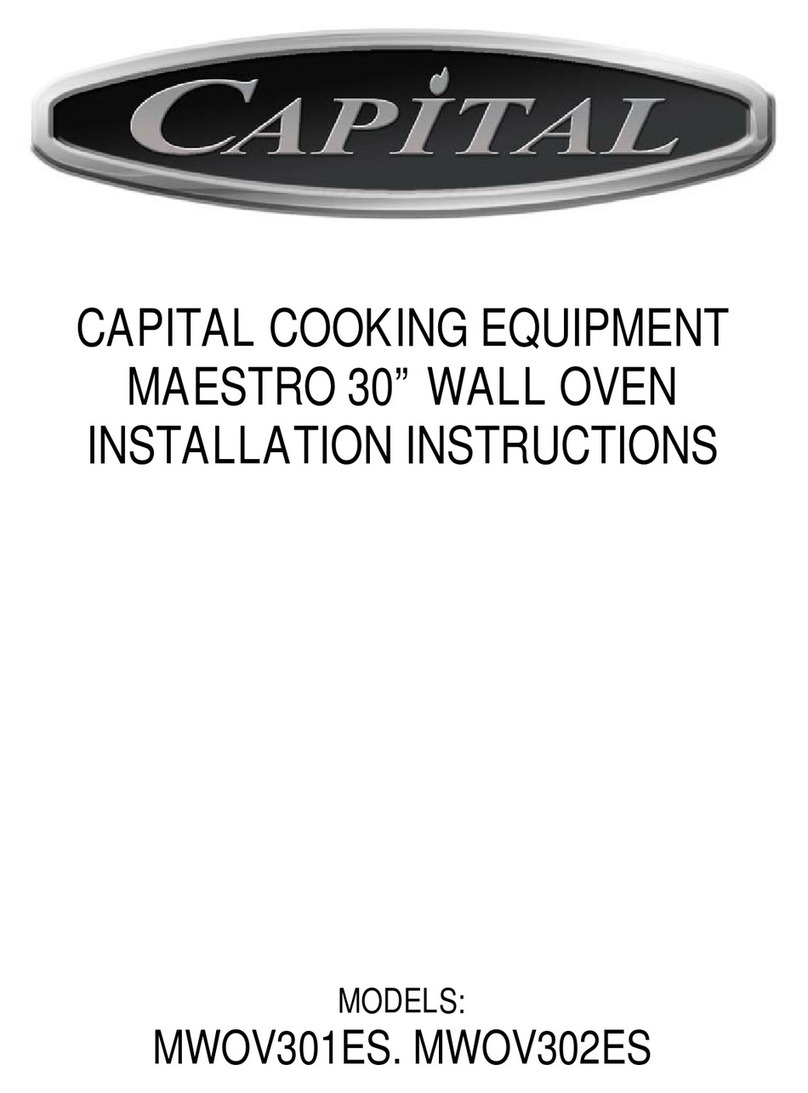
Capital
Capital Maestro Series MWOV301ES installation instructions

Bosch
Bosch HBF113B 0Q Series User manual and installation instructions

Wolf
Wolf Wall Oven-2 Series Technical & service manual

AEG
AEG BSE792280M user manual
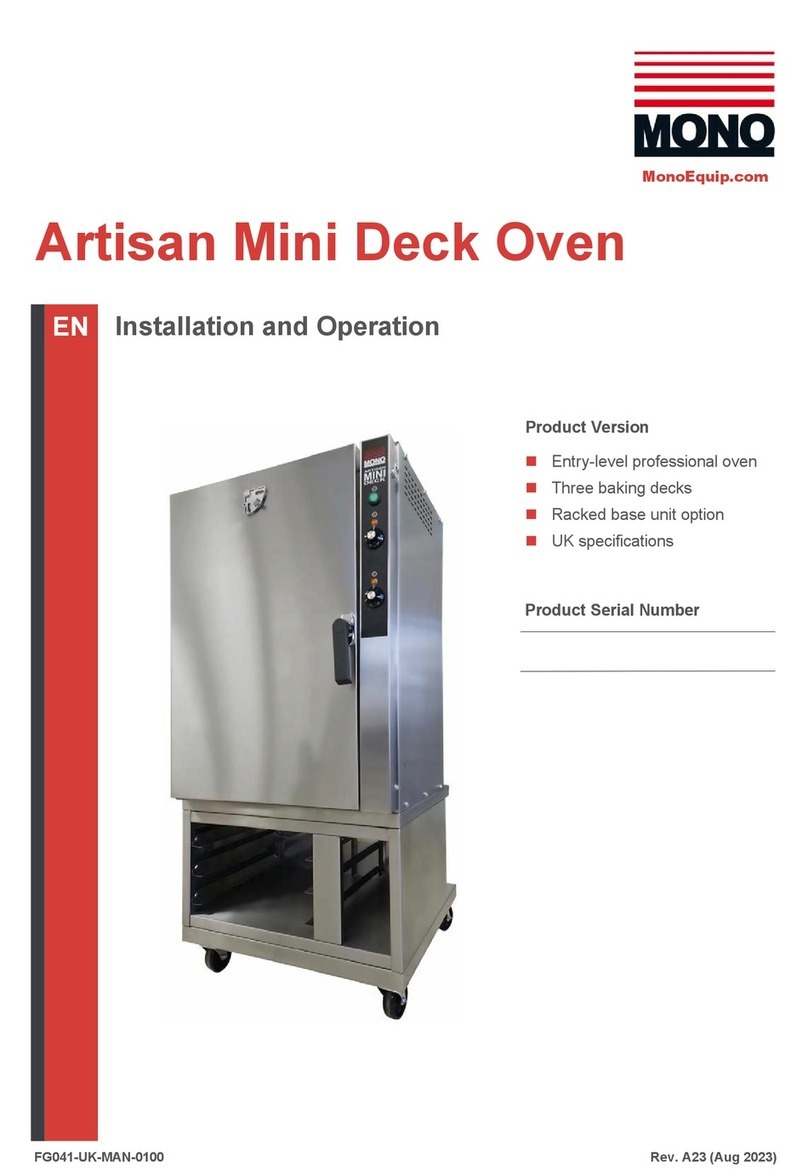
Mono
Mono Artisan Mini Deck Installation and operation manual
